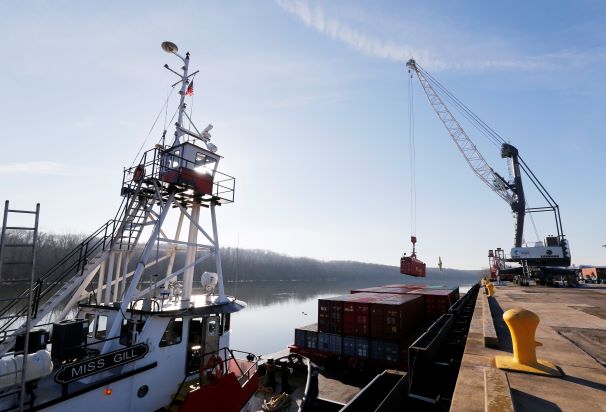Archives
Freight News, Sea
Port of Virginia Marks Decade of Success for the Richmond Barge Service
[ December 29, 2018 // Gary G Burrows ]A decade ago, ideas, opportunity and timing converged to make a weekly container-onbarge service that connects The Port of Virginia’s® cargo terminals in the Norfolk Harbor to the marine terminal in Richmond a reality.
Over the 12 months of 2008, a total of 149 containers were loaded onto a barge — retrofitted to handle containers — and made the journey along the James River to what was then called the Port of Richmond. Now, 10 years later, more than 130,000 containers have made the trip up and down the river.
“What has been achieved by leveraging the barge is a real accomplishment,” says John F. Reinhart, the CEO and executive director of the Virginia Port Authority (VPA). “Because of the success that we’re having, we are increasing the number of sailings per week. In turn, we’re accelerating our investment in the terminal, which leads to economic investment and job creation in the immediate area.
“This operation has set the standard for how to develop a sustainable barge service. Richmond is maturing into an important inland transit point for cargo and has become integral to our operation.”
In 2008, despite its strategic location on I-95 and proximity to interstates 64 and 81, the Port of Richmond was struggling. Though it was servicing a small number of truck moves and leasing some space on-terminal for storage, it hadn’t seen any activity on its wharf in nearly two years. The Great Recession forced the port’s last remaining ocean carrier customers to cancel their service to Richmond. As maritime activity at the port ceased, officials from the state and City of Richmond began looking for opportunities to restore the port’s viability.
With encouragement from the U.S. Department of Transportation’s Maritime Administration (MARAD), the Richmond Regional Transportation Planning Organization (RRTPO) funded the start-up of the barge: the project went from concept to launch in 14 months. The VPA was a key partner in supporting the move and in January 2008, a barge carrying 14 containers and chassis left the Norfolk Harbor bound for Richmond.
“The Richmond Marine Terminal and its success are representative of the kind of collaborative ingenuity necessary to expand the use of marine highways nationwide,” says Maritime Administrator Mark H. Buzby. “The expansion of Richmond’s port and its barge service continue to encourage shippers to make waterborne transport a routine option in a very competitive industry.”
Following the start-up of the barge service, the VPA entered into a short-term lease with the City of Richmond to manage the port. In February 2016, the VPA renewed that lease agreeing to a 40-year term that allowed for management, operation and marketing of the terminal. As a result of that agreement, the VPA rebranded the terminal, changing the name to Richmond Marine Terminal (RMT) and worked with the RRTPO to acquire a $4.2 million mobile harbor crane. That investment signaled the start of the VPA’s long-term capital plan for the terminal, which supports an economic development strategy to drive investment in the area around the RMT.
The results have been significant:
• This year, nearly 30,000 containers will move between RMT and the Norfolk Harbor on the barge, making 2018 the busiest in history for the Richmond Express barge service (formerly named the 64 Express).
• In the 10 years the port has operated and managed RMT, more than 130,000 containers have been processed at the terminal.
• The compound annual growth rate (2008-2018) is 71.3 percent.
• Fourteen ocean carriers offer bills of lading with RMT as the final destination or point of origin for cargo.
• The number of barge sailings have grown from one- to three-times a week, and more sailings are being discussed.
• A second barge, better configured for refrigerated containers was purchased and placed into service in late 2016.
• A third barge has been purchased and will provide the capacity to increase the number of weekly sailings, based on demand.
• In 2012, the VPA received a federal DERA grant (Diesel Emission Reduction Act) to repower the tug that moves the barge with a new, low-emissions engine.
• A power unit that can supply electricity to as many as 40 refrigerated units was added to the barge in 2017.
• Two large speculative warehouses (Panattoni and Hourigan are the developers) in the immediate area around RMT are under construction.
• A European-based grocer that is making inroads along the U.S. East Coast chose a location near RMT to take advantage of the barge service.
• Maintenance dredging alongside RMT’s berth has been completed and ensures the necessary depth for safe operation of the barge.
• Maintenance to ensure the safety of RMT’s wharf is underway.
Some of the more important aspects of the barge, Reinhart says, are its positive effect on congestion and the environment.
“The barge helps to reduce diesel emissions, wear-and-tear on the roads and truck traffic on I-64,” Reinhart says. “Since 2008 when the service began, the truck volume on I-64 has been reduced by more than one-quarterof-a-million truck trips: had it not been for the barge, every one of those containers would have gone onto a truck and moved between RMT and the Norfolk Harbor and most would have been a roundtrip move.”
2018-2008, Year-on-Year Barge Statistics
• 2018: 29,685 +23.7% (stats through November)
• 2017: 23,992 +22.5%
• 2016: 19,582 +34.4%
• 2015: 14,567 +26.7%
• 2014: 11,500 +44.4%
• 2013: 7.964 -1.3%
• 2012: 8,069 +84.2% • 2011: 4,381 -26.6%
• 2010: 5,969 +36.3%
• 2009: 4,379
• 2008: 149
• 2007: 14 (one month of operation)
Tags: Port of Virginia












